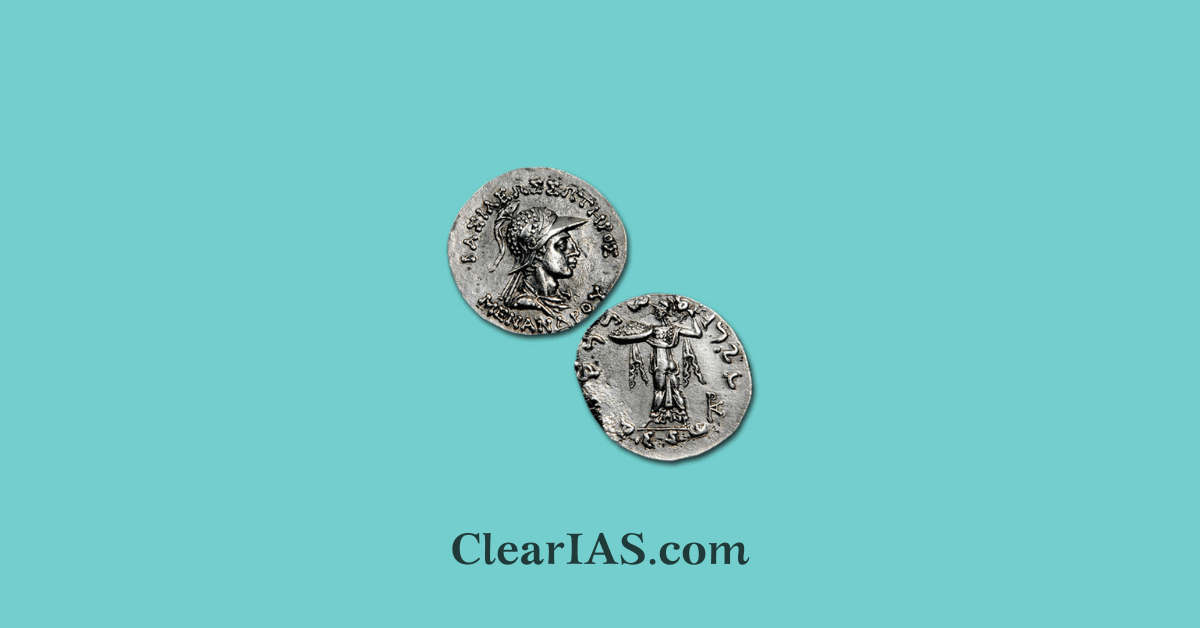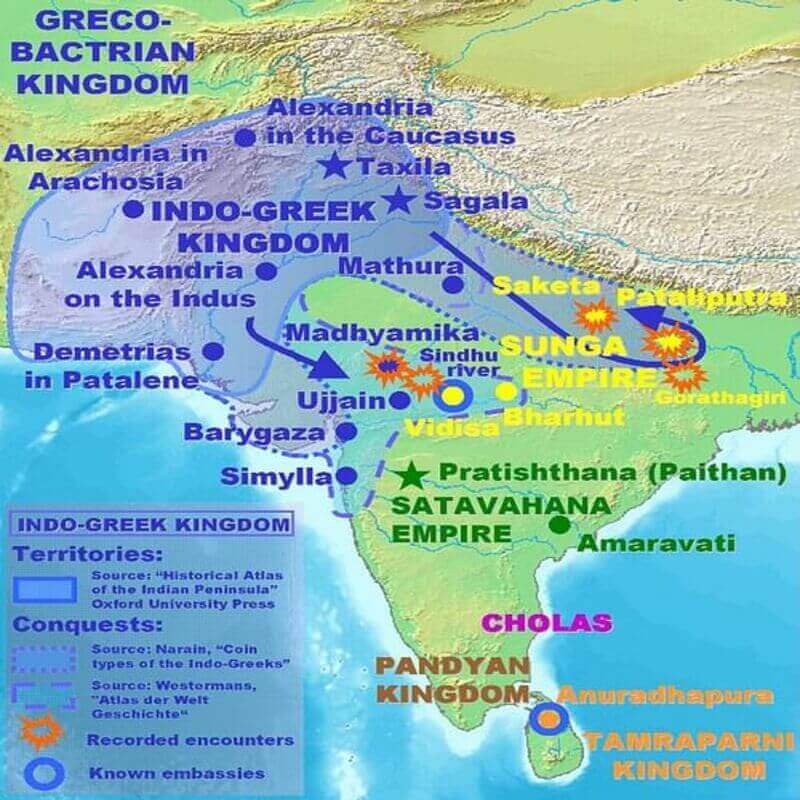
The Indo-Greek Kingdom is a historical period during which a series of Greek kingdoms ruled various parts of northern India, primarily in the northwestern region, from around the 2nd century BCE to the 1st century CE. Read here to learn more about them.
The Indo-Greek empire, also called the Graeco-Indian Kingdom or Yavana Kingdom (Yavanarajya) historically, was a Hellenistic-era Greek empire that included diverse regions of contemporary Afghanistan, Pakistan, and northwest India.
This kingdom existed from around 200 BCE to the start of the common period.
These kingdoms emerged as a result of the conquests of Alexander the Great and the subsequent establishment of Greek rulers in the area.
Initiation of the Greek presence in India
During the Persian Achaemenid era, the Northwestern region of the Indian subcontinent was first settled by the Greeks.
The region was subjugated by Darius the Great, who also subdued most of the Greek world at the time, and this encompassed the whole western Anatolian peninsula.
When Greek settlements resisted Persian oppression, they were occasionally moved to the opposite side of the empire as an act of ethnic cleansing.
As a result, the Persian Empire’s Indian provinces saw the growth of numerous Greek communities.
4th century BCE
Alexander the Great overthrew and conquered the Persian kingdom in the fourth century BCE.
- This comprised the westernmost portion of the Indian subcontinent up to the Hyphasis (Beas) River in 326 BCE.
- Alexander erected satrapies and several towns, including Bucephala; when his forces refused to move farther east, he turned south.
- The surviving Greek forces in these satrapies were placed under the direction of Alexander’s commander Eudemus.
- The Indian satrapies of Punjab were left under the administration of Porus and Taxiles, who were reconfirmed at the Treaty of Triparadisus in 321 BCE.
- After 321 BCE, Eudemus destroyed the Taxiles dynasty, but he left India in 316 BCE.
- Another general, Peithon, son, governed the Greek colonies of the Indus to the south.
Greco-Bactrian kingdom
Diodotus I was the founder of the Greco-Bactrian Kingdom, which was a precursor to the Indo-Greek Kingdoms.
- Alexander had also established several colonies in neighboring Bactria, such as Alexandria on the Oxus (modern Ai-Khanoum) and Alexandria of the Caucasus (medieval Kapisa, modern Bagram).
- After Alexander died in 323 BCE, Bactria came under the control of Seleucus I Nicator, who founded the Seleucid Empire.
- The Greco-Bactrian Kingdom was founded when Diodotus I, the satrap of Bactria seceded from the Seleucid Empire around 250 BCE.
3rd century BCE
In 305 BCE, Seleucus I Nicator and Chandragupta Maurya’s armies met at the Indus.
- Seleucus was one of Alexander’s successors and ended up ceding large portions of his territory in the northwest of India to Chandragupta Maurya in exchange for war elephants and a marital alliance.
- Several Greeks, such as the historian Megasthenes, followed by Deimachus and Dionysius, were sent to reside at the Mauryan court.
- Greek populations remained in the northwest of the Indian subcontinent under Mauryan rule.
- Chandragupta’s grandson Ashoka, who had converted to the Buddhist faith declared in the Edicts of Ashoka, set in stone, some of them written in Greek, that Greek populations within his realm also had converted to Buddhism.
- The Greeks in India even seem to have played an active role in the propagation of Buddhism.
2nd century BCE
In 206 BC, the Seleucid emperor Antiochus led an army to the Kabul valley, where he received war elephants and presents from the local king Sophagasenus.
In 185 BCE, the Maurya Dynasty was overthrown when Pushyamitra Shunga, the commander-in-chief of Mauryan Imperial forces and a Brahmin, assassinated the last of the Mauryan emperors Brihadratha.
- Pushyamitra Shunga then ascended the throne and established the Shunga Empire, which extended its control as far west as the Punjab.
Indo-Greek Kingdom

The first Indo-Greek state may have emerged about 190 BCE while the Greco-Bactrian king Demetrios was occupied in India.
- At that time, his Indian lands had been split among numerous rulers, likely first to improve their governance but later because of civil conflict.
- The reason why these kingdoms are commonly referred to as “Indo-Greek” is because they were virtually always cut off from Bactria and hence had different political systems than the Greco-Bactrian monarchy.
The elimination of the Mauryan dynasty by the Shungas encouraged the expansion of Indo-Greek kings.
The Indo-Greek Kingdoms were concentrated in the region comprising modern-day Pakistan and parts of northern India. The areas of Gandhara (northwestern Pakistan) and the Punjab region were particularly significant.
Prominent Indo-Greek rulers
Several Greek rulers established their rule in different parts of northern India during this period. Some of the prominent rulers included Demetrius I, Menander I, Eucratides I, and Strato I. Each ruler controlled varying territories and played a role in shaping the political landscape.
Menander I
In 165 BCE, the Greco-Bactrian rebel Eucratides invaded the Indo-Greek kingdoms and, defeating Antimachos II, succeeded to take control of most of the Indo-Greek possessions.
- But Menander I defeated and pushed him back to Bactria in 155 BCE.
- Menander extended Greek rule as far as Paliputra (today, Patna)
From 165 BCE until he died in 130 BCE, Menander I ruled Punjab with Sagala as his capital.
Menander is also remembered in Buddhist literature, where he is called Milinda, and is described in the Milinda Panha as a convert to Buddhism.
Here is a list of some of the prominent Indo-Greek rulers:
- Diodotus I: The founder of the Greco-Bactrian Kingdom, which was a precursor to the Indo-Greek Kingdoms.
- Demetrius I (c. 205–171 BCE): Also known as Demetrius I of Bactria, he established the Indo-Greek Kingdom in parts of northwestern India.
- Menander I (c. 165–130 BCE): One of the most well-known Indo-Greek rulers, he is often associated with his conversion to Buddhism.
- Apollodotus I (c. 180–160 BCE): He ruled in the northwestern Indian region of Gandhara and issued coins with both Greek and Indian influences.
- Antimachus I (c. 180–165 BCE): Another ruler in Gandhara, his coins display a mix of Greek and Indian styles.
- Eucratides I (c. 171–145 BCE): Eucratides expanded the Indo-Greek territories into Bactria and the northern regions of India.
- Menander II (c. 90 BCE): Also known as Menander II Soter, he ruled in the northwestern Indian region of Punjab.
- Heliokles II (c. 125 BCE): Heliokles ruled parts of northern India during the same period as Menander II.
- Strato I (c. 130–110 BCE): He ruled in the region of Punjab and was known for his coins depicting a variety of deities.
- Hermaeus (c. 90 BCE): Hermaeus ruled in the area of Kapisa in modern-day Afghanistan and parts of northwestern India.
- Hippostratos (c. 65 BCE): Hippostratos ruled in the region of Punjab and issued coins that showcased both Greek and Indian features.
- Telephos (c. 75 BCE): Little is known about Telephos, but his coins provide some historical insights.
- Dionysios (c. 65 BCE): Dionysios ruled in the region of Punjab and his coins reflect a fusion of Greek and Indian cultures.
- Philoxenos (c. 100 BCE): Philoxenos ruled in the region of Punjab and his coins are characterized by their unique iconography.
- Amyntas (c. 100 BCE): Amyntas ruled in the region of Kabul and his coins often featured Greek and Indian deities.
In 80 BCE, the Saka king Maues attacked the Indo-Greek kingdoms. He won against several Euthydemid and Eucratid kings, taking the Paropamisadae, Gandhara, and Western Punjab.
Over time, the Indo-Greek Kingdoms faced challenges from various factors, including internal conflicts, pressures from neighboring empires like the Parthians and the Kushans, and the gradual reassertion of indigenous Indian rule.
End of the Indo-Greek Kingdom
By the 1st century CE, the Indo-Greek Kingdoms had largely disintegrated, and their territories were absorbed by other empires.
The last Indo-Greek king Strato II ended his rule circa 10 BCE, defeated by the Indo-Saka king Rajuvula.
The expansion of the Kushan Empire and the rise of the Gupta Empire marked the decline of the Indo-Greek presence in the Indian subcontinent.
Influence of Indo-Greek Culture
The Indo-Greek Kingdom represents a fusion of Greek and Indian cultures, often referred to as Hellenistic culture.
This period saw the interaction and blending of Greek customs, art, and administrative practices with Indian traditions.
- The Indo-Greek Kingdoms facilitated a cross-cultural exchange between Greece and India. Greek artistic styles influenced local art, and elements of Indian religious and philosophical thought may have influenced Greek rulers.
- Some Indo-Greek rulers, such as Menander I, are known to have converted to Buddhism. This further contributed to the blending of Greek and Indian religious practices.
- Indo-Greek architecture is not as well-documented as their art, but there is evidence of Greek influence in certain structural elements, such as column design and the use of Corinthian capitals in some buildings.
Indo-Greek rulers issued a significant number of coins, which provide valuable historical and artistic insights. Bilingual inscriptions, written in Greek and local scripts, are also important sources of information.
- Coins circulated to the north of the Hindu Kush region during the rule of Indo-Greeks: There were gold, silver, copper, and nickel coins with Greek legends. The Indo-Greek coins had royal portraits on the obverse and Greek deities (Zeus, Apollo, and Athena) on the reverse.
- Coins circulated to the south of the Hindu Kush region during the rule of Indo-Greeks: There were silver and copper coins (mostly in square shape). Indian weight standards were followed in the making of these coins. They had bilingual inscriptions – Greek and Kharoshthi. On the obverse of the coin, royal portraits were present and, on the reverse, religious symbols (mostly Indian in inspiration) were present.
One of the most notable outcomes of the Indo-Greek cultural exchange is the Gandhara School of Art.
- Centered in the Gandhara region (modern-day Pakistan and Afghanistan), this school combined Greek techniques with Indian themes to create distinctive sculptures and reliefs.
- Sculptures from the Indo-Greek period reflect a mixture of Greek naturalism and Indian sensibilities.
- Greek influences are seen in the rendering of human anatomy, while Indian features are evident in the portrayal of clothing, hairstyles, and facial expressions.
The Indo-Greek Kingdoms played a significant role in shaping the cultural and historical landscape of the northwestern regions of the Indian subcontinent during their existence.
While their rule was relatively short-lived, their legacy continues to be reflected in historical records, coins, and artifacts that provide insights into the interactions between Greek and Indian cultures during ancient times.
-Article by Swathi Satish






Leave a Reply